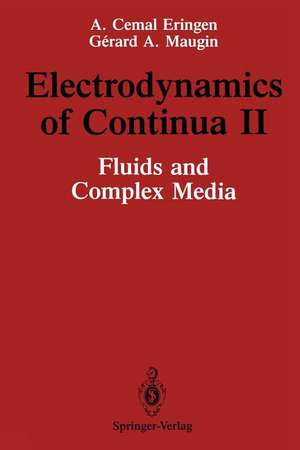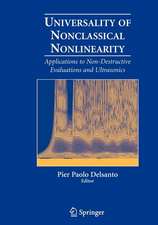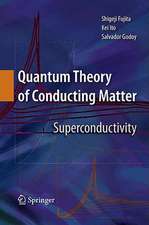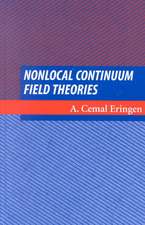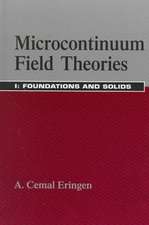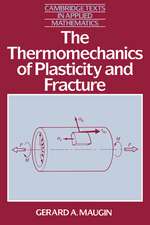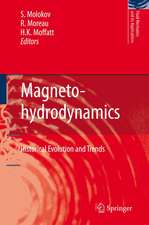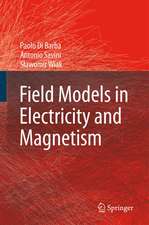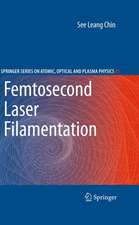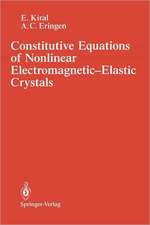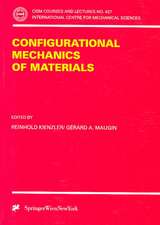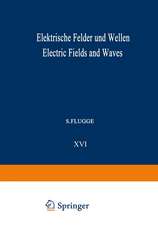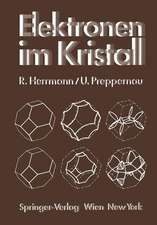Electrodynamics of Continua II: Fluids and Complex Media
Autor A. Cemal Eringen, Gerard A. Mauginen Limba Engleză Paperback – 17 sep 2011
Preț: 644.49 lei
Preț vechi: 758.23 lei
-15% Nou
Puncte Express: 967
Preț estimativ în valută:
123.34€ • 133.93$ • 103.60£
123.34€ • 133.93$ • 103.60£
Carte tipărită la comandă
Livrare economică 22 aprilie-06 mai
Preluare comenzi: 021 569.72.76
Specificații
ISBN-13: 9781461279280
ISBN-10: 1461279283
Pagini: 380
Ilustrații: XIII, 363 p.
Dimensiuni: 155 x 235 x 20 mm
Greutate: 0.53 kg
Ediția:Softcover reprint of the original 1st ed. 1990
Editura: Springer
Colecția Springer
Locul publicării:New York, NY, United States
ISBN-10: 1461279283
Pagini: 380
Ilustrații: XIII, 363 p.
Dimensiuni: 155 x 235 x 20 mm
Greutate: 0.53 kg
Ediția:Softcover reprint of the original 1st ed. 1990
Editura: Springer
Colecția Springer
Locul publicării:New York, NY, United States
Public țintă
ResearchCuprins
(Volume II).- 9 Elastic Ferromagnets.- 9.0. An Overview of Basic Equations.- 9.1. Scope of the Chapter.- 9.2. Model of Interactions.- 9.3. Balance Equations.- 9.4. Constitutive Theory.- 9.5. Résumé of Basic Equations.- 9.6. Coupled Magnetoelastic Waves in Ferromagnets.- 9.7. Applications of the Magnon-Phonon Coupling.- 9.8. Other Works.- 10 Magnetohydrodynamics.- 10.1. Scope of the Chapter.- 10.2. Basic Equations of Electromagnetic Fluids.- 10.3. Magnetohydrodynamic Approximation.- 10.4. Perfect Magnetohydrodynamics.- 10.5. Incompressible Viscous Magnetohydrodynamic Flow.- 10.6. One-Dimensional Compressible Flow.- 10.7. Shock Waves in Magnetohydrodynamics.- 10.8. Magnetohydrodynamic Equilibria.- 10.9. Equilibrium of Magnetic Stars.- 10.10. Magnetohydrodynamic Stability.- 11 Eleetrohydrodynamics.- 11.1. Scope of the Chapter.- 11.2. Field Equations.- 11.3. Charge Relaxation.- 11.4. Stability Condition.- 11.5. Helmholtz and Bernoulli Equations.- 11.6. Equilibrium of a Free Interface.- 11.7. Effect of Free Charges at an Interface.- 11.8. Electrohydrodynamic Stability.- 11.9. Electrohydrodynamic Flow in a Circular Cylindrical Conduit.- 11.10. Electrogasdynamic Energy Converter.- 12 Ferrofluids.- 12.1. Scope of the Chapter.- 12.2. Constitutive Equations of Ferromagnetic Fluids.- 12.3. Theory of Ferrofluids.- 12.4. Existence and Stability of a Constant Magnetization in a Moving Ferrofluid.- 12.5. Ferrohydrodynamic Approximation.- 12.6. Some General Theorems in Ferrohydrodynamics.- 12.7. Ferrohydrostatics.- 12.8. Ferrohydrodynamic Flow of Nonviscous Fluids.- 12.9. Simple Shear of a Viscous Ferrofluid.- 12.10. Stagnation-Point Flow of a Viscous Ferrofluid.- 12.11. Interfacial Stability of Ferrofluids.- 12.12. Other Problems in Ferrofluids.- 13 Memory-Dependent ElectromagneticContinua.- 13.1. Scope of the Chapter.- 13.2. Constitutive Equations.- 13.3. Thermodynamics of Materials with Continuous Memory.- 13.4. Quasi-Linear and Linear Theories.- 13.5. Rigid Bodies.- 13.6. Dispersion and Absorption.- 13.7. A Simple Atomic Model.- 13.8. Free Motion of an Electron Under Magnetic Field.- 13.9. Electromagnetic Waves in Memory-Dependent Solids.- 13.10. Electromagnetic Waves in Isotropic Viscoelastic Materials.- 13.11. Nonlinear Atomic Models for Polarization.- 13.12. Constitutive Equations of Birefringent Viscoelastic Materials.- 13.13. Propagation of Waves in Birefringent Viscoelastic Materials.- 13.14. Photoviscoelasticity.- 14 Nonlocal Electrodynamics of Elastic Solids.- 14.1. Scope of the Chapter.- 14.2. Constitutive Equations.- 14.3. Thermodynamics.- 14.4. Linear Theory.- 14.5. Material Symmetry.- 14.6. Nature of Nonlocal Moduli.- 14.7. Nonlocal Rigid Solids.- 14.8. Electromagnetic Waves.- 14.9. Point Charge.- 14.10. Rigid Magnetic Solids.- 14.11. Superconductivity.- 14.12. Piezoelectric Waves.- 14.13. Infrared Dispersion and Lattice Vibrations.- 14.14. Memory-Dependent Nonlocal Electromagnetic Elastic Continua.- 14.15. Linear Nonlocal Theory for Electromagnetic Elastic Solids.- 14.16. Natural Optical Activity.- 14.17. Anomalous Skin Effects.- 15 Relativistic Electrodynamics of Continua.- 15.1. Scope of the Chapter.- 15.2. Space-Time, Notation.- 15.3. Relativistic Kinematics of Continua.- 15.4. Covariant Formulation of Maxwell’s Equations in Matter.- 15.5. Relativistically Invariant Balance Laws.- 15.6. Electromagnetic Interactions with Matter.- 15.7. Thermoelastic Electromagnetic Insulators.- 15.8. Electromagnetic Fluids.- 15.9. Further Problems in the Relativistic Electrodynamics of Continua.- References.
